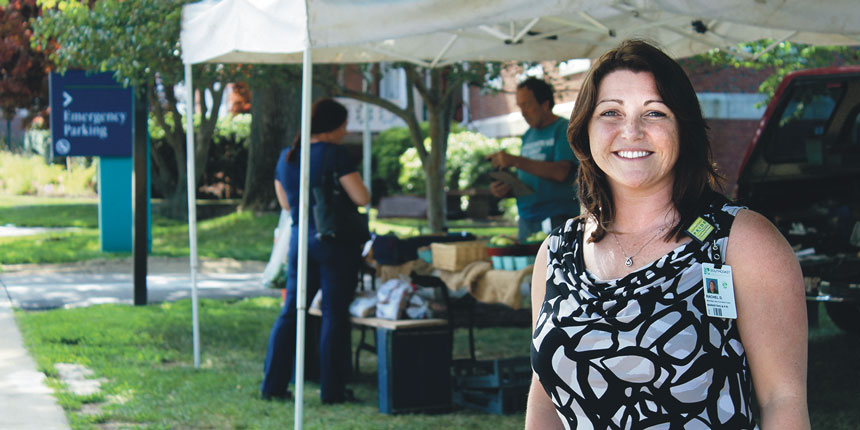Health+
Southcoast Invests in Our Community

Southcoast's Community Benefits program addresses community health needs with care
“We want to keep people healthy and out of the hospital, so our programs focus on the root causes that lead to chronic conditions and illness,” explains Rachel Davis, Southcoast Health community benefits manager. “Everyone we serve should have access to healthcare, nutritious food, timely health screenings and safe places to exercise — whether you’re uninsured, underinsured, on a low or fixed income, or uncertain where to turn for healthcare.”
This is the essence of population health and a founding tenet of Southcoast Health. In fiscal year 2017, Southcoast invested nearly $19 million in Community Benefits initiatives and programs to help overcome problems driving poor health conditions in Greater Fall River, New Bedford and Wareham.
Assessing needs
Southcoast’s Community Benefits Impact Opportunity program subsidizes initiatives that provide treatment and promote healing for pressing community health needs. But exactly how do Davis and her team allocate critical funds? It’s a comprehensive, data-driven assessment process, she explains. Southcoast Health conducts a Community Health Needs Assessment every three years, which includes demographic and socioeconomic analyses, health assessments (with a focus on health outcomes and disparities) and key informant and focus groups.
“We use the results of the Community Health Needs Assessments to develop a list of priorities and provide a framework for collaboration with community partners in order to address community needs,” Davis says.
Identifying health issues often begins with a deep dive into ZIP codes, Davis says. “Studies tell us that where you live, work and play is a leading health indicator. It’s not about whether these folks want to be healthy; it’s about whether they have the resources to stay healthy,” she explains.
For example, certain communities have access to healthy food and others are in a food desert. Some areas lack safe places for physical activity. Do community residents have transportation to and from their doctor’s office for timely health screenings? Are behavioral health and substance use intervention services keeping up with the South Coast region’s needs?
“A rigorous assessment process looks at all these factors and then gives us an objective view as to where Southcoast’s Community Benefits programs will make a significant difference,” Davis says.
Turning data into action
Southcoast Community Benefits translates data and assessment research into proactive programs. For example, Davis points to Southcoast’s public farm stands, held each summer at four Southcoast sites — Charlton Memorial Hospital in Fall River, St. Luke’s Hospital in New Bedford, Tobey Hospital in Wareham and the South Coast Business Center in Fairhaven.
The farm stands fall under Southcoast’s Healthy System and Environment Change program. A local farmer, who accepts food stamp benefits as well as other public assistance programs, sets up a fresh fruit and vegetable stand. At day’s end, Southcoast purchases remaining produce and donates it to community organizations in need. “For example, in New Bedford, we donate produce to the United Way Hunger Commission. We’re supporting our local farmers, our community members as well as community programs,” Davis emphasizes.
Impacting behavioral health
In addition to providing programs to improve the physical health of residents, Southcoast also addresses existing behavioral health needs. The first step began with a comprehensive, behavioral health needs assessment of the South Coast.
“We found gaps between our service providers,” Davis recalls. “Communication between providers was fragmented, and it was clear that a leading issue was lack of knowledge of other existing resources. So, with input from our community, we created an online tool that helps inform providers and community members alike regarding available resources across the region.”
The impact of this tool has been “impressive,” Davis says. Behavioral Health Connect, a free, online directory of local behavioral health services and a wide range of community resources, surpassed expectations. The statistics show why: From 2016 to 2017, sessions increased by 173 percent, users increased 175 percent and online page views increased by 142 percent.
The Southcoast Health Community Benefits program mission remains constant: remove barriers to healthcare where the needs are greatest. However, Davis stresses, Community Benefits programs are reviewed annually. “Community needs are data driven, but that data is not static,” she adds. “We’re always evaluating our programs. As our communities’ needs change, we change our programs to meet those needs.”
This year, Southcoast Health awarded a total of $142,065 to 39 local, nonprofit organizations. To learn how the grants help these community organizations address our community’s unmet health needs, visit southcoast.org/impactgrants.
